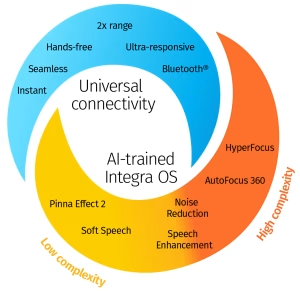

Effective communication in noisy environments can be particularly challenging for individuals with hearing loss. However, there are various strategies and technologies available that can significantly improve hearing in noise and enhance communication abilities. This essay explores several suggestions and recommendations to optimize hearing in noisy environments. We will cover the issues of environmental considerations, the importance of appropriate amplification, the role of directional microphones in hearing aids, and the use of accessories for better hearing in background noise.
What is that you ask? First, you want to focus on the speaker. Concentrate on the speaker’s face and gestures to gather visual cues. Maintaining eye contact can help aid in capturing important non-verbal communication.
Quickly ask for clarification when you miss something in a noisy environment. Don’t hesitate to ask the speaker to repeat or rephrase something if you missed it. Requesting clarification demonstrates your active engagement and helps ensure a clear understanding. Hears to U professionals recommend to repeat back what you thought you heard as that helps reduce the ambiguity of where the breakdown occurred.
Try to reduce background noise whenever possible, trying to minimize or eliminate unnecessary background noise. This could involve turning off the television or radio, closing windows, or moving to a quieter area. Sometimes it is impossible to reduce the noise but next time plan to find a quieter restaurant for instance.
Take Turns Speaking with your family or friend group. Encourage turn-taking during conversations to avoid overlapping speech. This allows for better comprehension and reduces the strain of trying to decipher multiple voices simultaneously. Sometimes it isn’t possible but it doesn’t hurt to explain to your family. I know in my family, everyone has something to say. So good luck to anyone in my family who has a hearing loss, which is both my parents, myself, and my significant other.
Make sure you educate others and inform your conversation partners about your hearing loss. Provide them with tips on how they can support effective communication. Encourage them to speak, face you directly, and minimize distractions.
We recommend that you advocate for accommodations. In group settings or public spaces, kindly request accommodations such as preferential seating or the use of assistive listening systems to enhance your ability to hear and participate.
Remember the Americans with Disabilities Act (ADA), which is a comprehensive civil rights law that prohibits discrimination against individuals with disabilities in various aspects of life, including public accommodations. Anyway, in terms of hearing accessibility, the ADA mandates that public entities and businesses provide equal access and reasonable accommodations to individuals with hearing loss. This includes ensuring effective communication through the use of auxiliary aids and services, such as sign language interpreters, captioning, and assistive listening devices. The ADA aims to create an inclusive society where individuals with hearing loss can fully participate in public activities, access services, and enjoy equal opportunities without facing barriers due to their hearing impairment. Compliance with the ADA helps promote equal access and enhances the quality of life for individuals with hearing loss.
Speechreading cues involve using visual information, such as lip movements, facial expressions, and gestures, to supplement auditory understanding during communication. These cues can provide valuable context and assist in deciphering speech. Examples include observing lip shapes for sounds like “p,” “b,” and “m,” paying attention to facial expressions for emotional cues and utilizing body language and gestures to gather additional information. Speech reading allows for some redundancy so that it is easier to understand what someone is saying.
Utilize contextual cues and visual information to fill in gaps in understanding. Pay attention to body language, facial expressions, and gestures that may provide additional context to the conversation.
Consider Acoustic Treatment, making modifications to the physical environment to reduce reverberation and improve speech clarity. Adding carpets, curtains, or acoustic panels can help absorb sound reflections and minimize background noise.
Seating Arrangements are key to helping one hear better in a noisy environment: opt for seating arrangements that promote better communication. Sitting closer to the speaker, away from noise sources, and in well-lit areas can enhance the listening experience.
Relaxation and Stress Reduction help everything including hearing better in noisy environments.
High levels of stress or fatigue can worsen communication difficulties. Practice stress reduction techniques, such as deep breathing exercises, meditation, or engaging in hobbies, to promote overall well-being and reduce tension.
Take Breaks if you find yourself struggling to follow conversations, it’s okay to take short breaks to rest and recharge. This can help prevent mental fatigue while trying to listen in all that noise and improve focus when returning to the conversation.
By implementing a combination of these strategies, individuals with hearing loss can navigate noisy environments more effectively and improve their communication outcomes. It’s important to find a personalized approach that works best for each individual, considering their specific hearing needs and preferences.
These devices work in tandem with hearing aids to provide enhanced clarity and focus on speech signals while reducing the impact of surrounding noise. Here are some popular hearing aid accessories designed specifically for addressing background noise:
Remote microphones are one of our favorite products which help people with hearing aids hear better in background noise. These microphones are portable devices that can be worn by a conversation partner or placed on a nearby surface. They capture the speaker’s voice and wirelessly transmit it directly to the wearer’s hearing aids. By placing the microphone closer to the source of the sound, remote microphones significantly improve speech intelligibility, even in noisy environments. They help overcome the challenges of distance and background noise, enabling the wearer to hear the speaker’s voice more clearly.
FM (Frequency Modulation) systems consist of a transmitter and a receiver. The transmitter is worn by the speaker, and the receiver is connected to the wearer’s hearing aids. The transmitter picks up the speaker’s voice and wirelessly transmits it to the receiver, which then delivers the sound directly to the hearing aids. FM systems can greatly improve speech understanding in noisy situations by reducing the effects of distance and background noise.
Bluetooth streamers are devices that enable wireless connectivity between hearing aids and various audio sources, such as smartphones, TVs, or other multimedia devices. By streaming audio directly to the hearing aids, Bluetooth streamers allow the wearer to listen to desired sounds without the interference of background noise. This can be particularly useful in situations where background noise is prevalent, such as crowded public spaces or social gatherings.
ALDs encompass a range of devices designed to improve hearing in specific situations. These devices include amplified telephones, TV listening systems, and personal amplifiers. Amplified telephones increase the volume of the incoming sound, making it easier to understand conversations over the phone. TV listening systems wirelessly transmit the TV’s audio directly to the wearer’s hearing aids, enabling clear listening without raising the volume for others. Personal amplifiers are compact devices that can be pointed toward the sound source, amplifying the desired sound while reducing background noise.
Many hearing aid manufacturers provide smartphone apps that allow wearers to adjust their hearing aids’ settings and personalize their listening experience. Some apps also offer additional features like directional microphones control or noise reduction settings specifically designed for challenging environments. Additionally, there are smartphone-compatible accessories such as clip-on microphones or audio streamers that provide further assistance in hearing speech in noisy situations.
A hearing loop can improve hearing in noise. Also known as an induction loop, is a assistive listening system that uses a magnetic field to wirelessly transmit sound directly to hearing aids equipped with a telecoil (T coil) receiver. The T coil, a small coil of wire in hearing aids, allows individuals to connect to hearing loop systems, providing clearer and more direct audio signals over a noise floor in various settings, such as theaters, places of worship, and public spaces.
It’s important to note that the availability and compatibility of these accessories may vary depending on the hearing aid brand and model. Consultation with an audiologist or hearing care professional is recommended to determine the most suitable accessories based on individual needs and hearing aid compatibility.
In conclusion, hearing aid accessories such as remote microphones, FM systems, Bluetooth streamers, ALDs, and smartphone apps can greatly enhance communication in background noise. These accessories offer direct access to the desired sound source, reduce the impact of surrounding noise, and improve speech clarity, allowing individuals with hearing loss to actively engage and participate in conversations even in challenging listening environments.
Thanks for reading and we hope this helped you hear better in noise. It is important. We are here to help you as well!
Powered By SinglerDesign.com